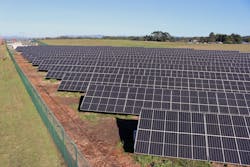California Utilities Launch New Microgrid Incentives for Disadvantaged Communities
California’s three investor-owned utilities have launched the Microgrid Incentive Program (MIP), which provides up to $15 million in funding for community microgrid projects in disadvantaged and vulnerable communities.
But it’s unclear whether these communities have the time and resources needed to jump through the application hoops and complete the technical work needed to propose and deploy projects.
Upfront funding would help disadvantaged communities
“There's a huge disconnect between the way state programs typically operate and the on-the-ground reality on a community level, where there is not usually capacity available to provide the upfront time needed to submit an application,” said Kurt Johnson, community energy resilience director for The Climate Center, which has a goal of cutting climate pollution. “What's desperately needed is upfront funding for energy resilience planning for communities.”
Even for communities that aren’t disadvantaged, deploying a community microgrid is a challenging task. For example, the Oakmont Energy Resiliency Project has encountered obstacles planning a community microgrid that would help protect residents – whose average age is 75 – during outages, said Ken Smith, former chair of the project. The committee Smith chaired has disbanded because the community’s homeowners association said it can’t give the group any more money under its bylaws, Smith said.
“I’ve been trying to make this happen, and I’m just one guy not getting support from the community,” Smith recently told Microgrid Knowledge.
Under the MIP, disadvantaged and vulnerable communities can apply to the statewide $200 million competitive grant program to fund clean energy community microgrids. The California Public Utilities Commission (CPUC) allocated $79.2 million in funding for Pacific Gas & Electric (PG&E), $83.3 million for Southern California Edison, and $17.5 million for San Diego Gas and Electric.
The CPUC is offering Clean Energy Access grants of up to $500,000 to help disadvantaged communities access or provide education about the MIP program, which is an outgrowth of California SB 1339, a bill that aimed to commercialize microgrids.
Up to $15 million per qualifying project available
Each utility program is slightly different. For PG&E, projects that qualify under the program can receive up to $15 million each in funding for the design and development of a multi customer, front-of-the-meter community microgrid.
Along with announcing the MIP, PG&E has changed the eligibility requirements for its Community Microgrid Enablement Program (CMEP), limiting it to disadvantaged and vulnerable communities. Under that program, PG&E provides technical and financial support for community microgrids, said Molly Hoyt, principal program manager for PG&E.
The MIP and CMEP together will help get community microgrids off the ground in vulnerable and disadvantaged communities, with CMEP paying primarily for islanding-related costs and MIP paying for the design and development of full microgrids, Hoyt said.
Microgrid industry members encouraged to partner with communities
Both programs will require an all hands on deck approach to helping disadvantaged communities apply for funding and deploy microgrids, she said.
“We need everyone working together collaboratively to understand the programs and understand how they can work together,” Hoyt said. A top priority is encouraging microgrid developers to partner with communities to apply for funding. Under the MIP, communities can be reimbursed for $25,000 in technical design assistance for doing the work needed to jump-start these projects – but can’t get the $25,000 up front, as proposed by The Climate Center. Communities can receive the $25,000 reimbursement even if their projects aren’t completed, said Hoyt.
Successfully funding community microgrids in disadvantaged and vulnerable communities will require the involvement of private sector participants leading the development of these projects, said Johnson.
That’s not how The Climate Center had originally envisioned the program.
“We were hoping the structure would empower local communities to lead, starting with up-front planning money provided to community-based organizations in disadvantaged communities,” he said.
PG&E seeks highest benefits per ratepayer dollar
Under the PG&E program, the winning applications will provide the highest resilience and environmental benefits per ratepayer dollar, said Hoyt.
PG&E is now reaching out to developers, communities and people who expressed interest in the MIP at the CPUC, she said. The utility has reached out to more than 100 companies in the microgrid space this week.
“Absolutely the private sector will play a key role, and we’re happy to engage with project developers, owners and engineers to help them understand the program and work with communities,” said Hoyt.
Webinars designed to educate interested parties
Microgrid industry members can learn more about the program and how they can partner with communities and tribes by attending two webinars organized by PG&E. The first, an informational webinar, will be held 12 p.m.-1 p.m. PST, Oct. 17. Register here. The second, a technical webinar, will be held 1 p.m.-2 p.m. PST, Oct. 24. Register here.
PG&E also released a handbook describing the program and how to apply. The handbook includes information about all the incentives and allowances available, including details on eligibility, how to apply for funding and the process for developing a community microgrid.
While the CMEP has been in effect for two years, only one project, the Redwood Coast Airport Microgrid, has been developed so far as a result of it. The Green Power Institute and other nonprofits have argued that the Redwood Coast project got off the ground because it received a $5 million grant from the California Energy Commission's EPIC program and $6 million in matching funds from the Redwood Coast Energy Authority – not because it was part of the CMEP.
Large-scale projects expected to be deployed
PG&E expects that the new MIP incentives will lead to several large-scale community microgrids.
“We do have quite a few communities that have approached us over the last year or two effectively waiting for MIP and are excited to engage with MIP,” Hoyt said.
Meanwhile, the Oakmont seniors’ project is at a standstill. The project doesn’t meet the disadvantaged community requirements needed to receive MIP and CMEP funding. The group’s challenges are similar to those The Climate Center expects disadvantaged communities to encounter; there is no up-front funding available to kick-start the planning process.
“There is no community organization in place to accomplish [this] ... nor any funds available for creating one or hiring professional consultants,” Smith said.








